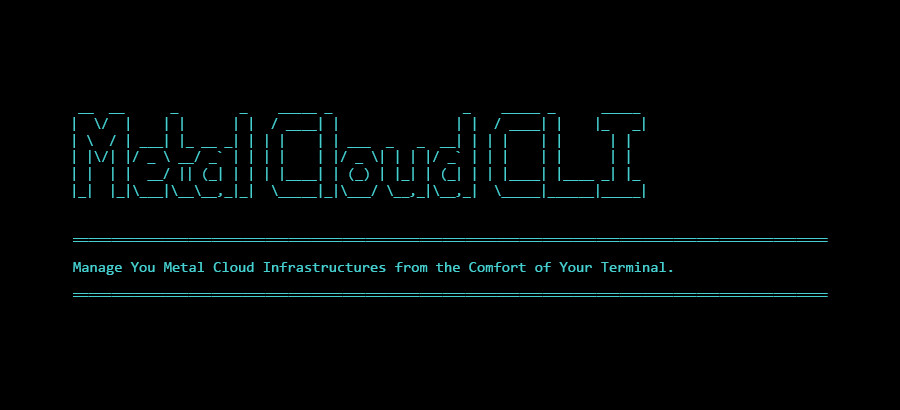- Advertising
- Bare Metal
- Bare Metal Cloud
- Benchmarks
- Big Data Benchmarks
- Big Data Experts Interviews
- Big Data Technologies
- Big Data Use Cases
- Big Data Week
- Cloud
- Data Lake as a Service
- Databases
- Dedicated Servers
- Disaster Recovery
- Features
- Fun
- GoTech World
- Hadoop
- Healthcare
- Industry Standards
- Insurance
- Linux
- News
- NoSQL
- Online Retail
- People of Bigstep
- Performance for Big Data Apps
- Press
- Press Corner
- Security
- Tech Trends
- Tutorial
- What is Big Data
Releasing a Brand New Metal Cloud CLI
We have just released our new Metal Cloud CLI, a new tool that will allow sysadmins to move a lot faster in working with metal cloud infrastructure elements. It is written in go and it is available on Bigstep's Github repository. Scroll down for details.

Installing metalcloud-cli
The CLI is a lightweight, single binary application written in go. We provide packages for all major platforms including MacOS and Windows.
Mac OS X
brew tap bigstepinc/homebrew-repo
brew install metalcloud-cliLinux
Deb and RPM packages available on Github. Use the installation method apropriate for your environment. Some examples are provided on the project's github page.
Ubuntu/Debian
curl -sLO https://github.com/bigstepinc/metalcloud-cli/releases/download/v1.0.3/metalcloud-cli_1.0.3_linux_amd64.deb && sudo dpkg -i metalcloud-cli_1.0.3_linux_amd64.debCentOS/Redhat
sudo rpm -i https://github.com/bigstepinc/metalcloud-cli/releases/download/v1.0.3/metalcloud-cli_1.0.3_linux_amd64.rpmGo install tool (all platforms, including Windows)
go get github.com/bigstepinc/metalcloud-cli
Getting started
Configure access credentials as environment variables:
export METALCLOUD_API_KEY="<your key>"
export METALCLOUD_ENDPOINT="https://api.bigstep.com/metal-cloud"
export METALCLOUD_USER_EMAIL="<your email>"
export METALCLOUD_DATACENTER="uk-reading"
To create an infrastructure:
$ metalcloud-cli create infrastructure -label test
$ metalcloud-cli list infrastructure
+-------+-----------------------------------------+-------------------------------+-----------+-----------+---------------------+---------------------+
| ID | LABEL | OWNER | REL. | STATUS | CREATED | UPDATED |
+-------+-----------------------------------------+-------------------------------+-----------+-----------+---------------------+---------------------+
| 12345 | test | d.d@sdd.com | OWNER | active | 2019-03-28T15:23:08Z| 2019-03-28T15:23:08Z|
+-------+-----------------------------------------+-------------------------------+-----------+-----------+---------------------+---------------------+To create an instance array in that infrastructure:
metalcloud-cli create instance_array -infra test -label master -proc 1 -proc_core_count 8 -ram 16metalcloud-cli list instance_array -infra test
+-------+---------------------+---------------------+-----------+ | ID | LABEL | STATUS | INST_CNT | +-------+---------------------+---------------------+-----------+ | 54321 | master | ordered | 1 | +-------+---------------------+---------------------+-----------+ Total: 1 Instance Arrays
To create a drive array and attach it to the previous instance array:
$ metalcloud-cli create drive_array -infra test -label master-da -ia 54321To view the current status of the infrastructure
$ metalcloud-cli get infrastructure -id 12345
Infrastructures I have access to (as test@test.com)
+-------+----------------+-------------------------------+-----------------------------------------------------------------------+-----------+
| ID | OBJECT_TYPE | LABEL | DETAILS | STATUS |
+-------+----------------+-------------------------------+-----------------------------------------------------------------------+-----------+
| 36791 | InstanceArray | master | 1 instances (16 RAM, 8 cores, 1 disks) | ordered |
| 47398 | DriveArray | master-da | 1 drives - 40.0 GB iscsi_ssd (volume_template:0) attached to: 36791 | ordered |
+-------+----------------+-------------------------------+-----------------------------------------------------------------------+-----------+
Total: 2 elements
This is the output of the metalcloud-cli help command:
Syntax: ./metalcloud-cli <command> [args]
Accepted commands:
Command: create infrastructure Creates an infrastructure. (alternatively use "new infra")
-dc (Required) Infrastructure datacenter
-label (Required) Infrastructure's label
-return_id (Flag) If set will print the ID of the created infrastructure. Useful for automating tasks.
-h Show command help and exit.
Command: list infrastructure Lists all infrastructures. (alternatively use "ls infra")
-format The output format. Supported values are 'json','csv'. The default format is human readable.
-h Show command help and exit.
Command: delete infrastructure Delete an infrastructure. (alternatively use "rm infra")
-autoconfirm (Flag) If set it does not ask for confirmation anymore
-id (Required) Infrastructure's id or label. Note that using the 'label' might be ambiguous in certain situations.
-h Show command help and exit.
Command: deploy infrastructure Deploy an infrastructure. (alternatively use "apply infra")
-allow_data_loss (Flag) If set, deploy will throw error if data loss is expected.
-autoconfirm (Flag) If set operation procedes without asking for confirmation
-id (Required) Infrastructure's id or label. Note that using the 'label' might be ambiguous in certain situations.
-no_attempt_soft_shutdown (Flag) If set,do not atempt a soft (ACPI) power off of all the servers in the infrastructure before the deploy
-no_hard_shutdown_after_timeout (Flag) If set do not force a hard power off after timeout expired and the server is not powered off.
-skip_ansible (Flag) If set, some automatic provisioning steps will be skipped. This parameter should generally be ignored.
-soft_shutdown_timeout_seconds (Optional, default 180) Timeout to wait if hard_shutdown_after_timeout is set.
-h Show command help and exit.
Command: get infrastructure Get an infrastructure. (alternatively use "show infra")
-format The output format. Supported values are 'json','csv'. The default format is human readable.
-id (Required) Infrastructure's id or label. Note that using the 'label' might be ambiguous in certain situations.
-h Show command help and exit.
Command: revert infrastructure Revert all changes of an infrastructure. (alternatively use "undo infra")
-autoconfirm (Flag) If set it does not ask for confirmation anymore
-id (Required) Infrastructure's id or label. Note that using the 'label' might be ambiguous in certain situations.
-h Show command help and exit.
Command: create instance_array Creates an instance array. (alternatively use "new ia")
-boot InstanceArray's boot type:'pxe_iscsi','local_drives'
-disk_size InstanceArray's local disks' size in MB
-disks InstanceArray's number of local drives
-firewall_management_disabled (Flag) If set InstanceArray's firewall management on or off
-infra (Required) Infrastructure's id or label. Note that the 'label' this be ambiguous in certain situations.
-instance_count (Required) Instance count of this instance array
-label InstanceArray's label
-proc InstanceArray's minimum processor count
-proc_core_count InstanceArray's minimum processor core count
-proc_freq InstanceArray's minimum processor frequency (Mhz)
-ram InstanceArray's minimum RAM (GB)
-return_id (Flag) If set will print the ID of the created Instance Array. Useful for automating tasks.
-template InstanceArray's volume template when booting from for local drives
-h Show command help and exit.
Command: list instance_array Lists all instance arrays of an infrastructure. (alternatively use "ls ia")
-format The output format. Supported values are 'json','csv'. The default format is human readable.
-infra (Required) Infrastructure ID
-h Show command help and exit.
Command: delete instance_array Delete instance array. (alternatively use "rm ia")
-autoconfirm If true it does not ask for confirmation anymore
-id (Required) InstanceArray ID
-h Show command help and exit.
Command: edit instance_array Edits an instance array. (alternatively use "alter ia")
-boot InstanceArray's boot type:'pxe_iscsi','local_drives'
-disk_size InstanceArray's local disks' size in MB
-disks InstanceArray's number of local drives
-do_not_keep_detaching_drives (Flag) If set and the number of Instance objects is reduced, then the detaching Drive objects will be deleted. If it's set to true, the detaching Drive objects will not be deleted.
-firewall_management_disabled (Flag) If set InstanceArray's firewall management is off
-id (Required) InstanceArray's id
-instance_count Instance count of this instance array
-label (Required) InstanceArray's label
-proc InstanceArray's minimum processor count
-proc_core_count InstanceArray's minimum processor core count
-proc_freq InstanceArray's minimum processor frequency (Mhz)
-ram InstanceArray's minimum RAM (GB)
-swap_existing_hardware (Flag) If set all the hardware of the Instance objects is swapped to match the new InstanceArray specifications
-template InstanceArray's volume template when booting from for local drives
-h Show command help and exit.
Command: create drive_array Creates a drive array. (alternatively use "new da")
-count DriveArrays's drive count. Use this only for unconnected DriveArrays.
-ia (Required) The id of the instance array it is attached to. It can be zero for unattached Drive Arrays
-infra (Required) Infrastructure ID
-label (Required) The label of the drive array
-no_expand_with_ia (Flag) If set, auto-expand when the connected instance array expands is disabled
-return_id (Optional) Will print the ID of the created Drive Array. Useful for automating tasks.
-size (Optional, default = 40960) Drive arrays's size in MBytes
-template DriveArrays's volume template to clone when creating Drives
-type Possible values: iscsi_ssd, iscsi_hdd
-h Show command help and exit.
Command: edit drive_array Edit a drive array. (alternatively use "alter da")
-count DriveArrays's drive count. Use this only for unconnected DriveArrays.
-expand_with_ia Auto-expand when the connected instance array expands
-ia (Required) The id of the instance array it is attached to. It can be zero for unattached Drive Arrays
-id (Required) Drive Array's ID
-label (Required) The label of the drive array
-size (Optional, default = 40960) Drive arrays's size in MBytes
-template DriveArrays's volume template to clone when creating Drives
-type Possible values: iscsi_ssd, iscsi_hdd
-h Show command help and exit.
Command: list drive_array Lists all drive arrays of an infrastructure. (alternatively use "ls da")
-format The output format. Supported values are 'json','csv'. The default format is human readable.
-infra (Required) Infrastructure ID
-h Show command help and exit.
Command: delete drive_array Delete a drive array. (alternatively use "rm da")
-autoconfirm If true it does not ask for confirmation anymore
-id (Required) DriveArray's ID
-h Show command help and exit.
Command: list volume_templates Lists available volume templates (alternatively use "ls templates")
-format The output format. Supported values are 'json','csv'. The default format is human readable.
-local_only Show only templates that support local install
-pxe_only Show only templates that support pxe booting
-h Show command help and exit.
Command: list firewall_rule Lists instance array firewall rules (alternatively use "ls fw")
-format The output format. Supported values are 'json','csv'. The default format is human readable.
-ia (Required) The instance array id
-h Show command help and exit.
Command: add firewall_rule Add instance array firewall rule (alternatively use "new fw")
-description The firewall rule's description.
-destination The destination address to filter on. It can also be a range with the start and end values separated by a dash.
-ia (Required) The instance array id
-ip_address_type The IP address type of the firewall rule. Possible values: ipv4, ipv6.
-port The port to filter on. It can also be a range with the start and end values separated by a dash.
-protocol The protocol of the firewall rule. Possible values: all, icmp, tcp, udp.
-source The source address to filter on. It can also be a range with the start and end values separated by a dash.
-h Show command help and exit.
Command: delete firewall_rule Remove instance array firewall rule (alternatively use "rm fw")
-destination The destination address to filter on. It can also be a range with the start and end values separated by a dash.
-ia (Required) The instance array id
-ip_address_type The IP address type of the firewall rule. Possible values: ipv4, ipv6.
-port The port to filter on. It can also be a range with the start and end values separated by a dash.
-protocol The protocol of the firewall rule. Possible values: all, icmp, tcp, udp.
-source The source address to filter on. It can also be a range with the start and end values separated by a dash.
-h Show command help and exit.
We hope you enjoy it and let us know your feedback!
Readers also enjoyed:

Black Friday 2019: How to Be a Success Story


Leave a Reply
Your email address will not be published.